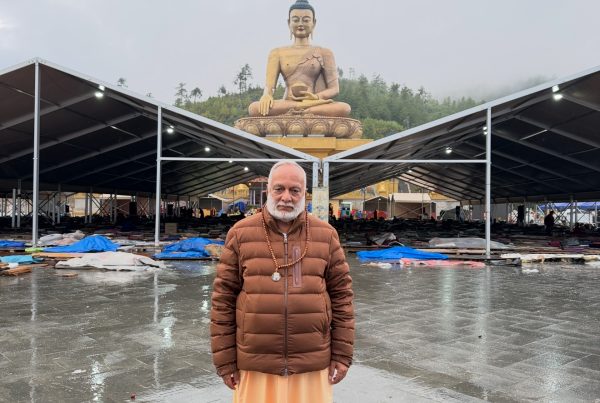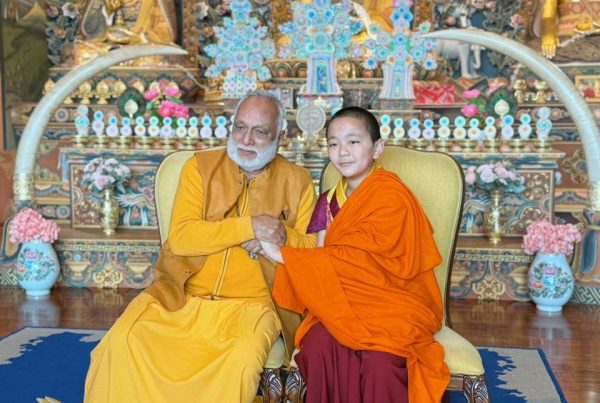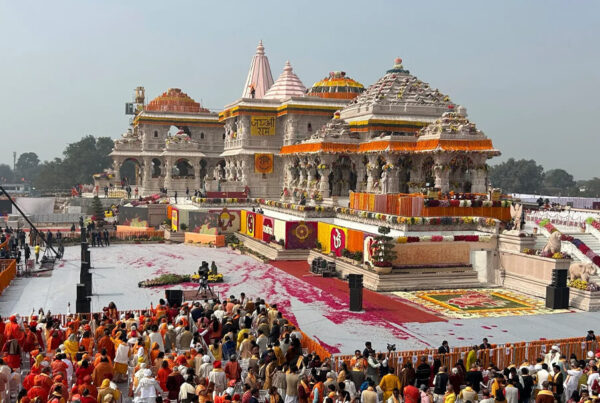
The presence of a wise person is like a rose that blooms in spring. Its beauty and fragrance permeate far and wide and attract all who have the receptivity and sensitivity to recognize it. The presence of a wise person affects not only humans but also trees, plants, animals, birds and other creatures. They respond to it.
Many such incidents are mentioned in the life of Buddha, when animals showed extraordinary sensitivity towards his wisdom. Once Buddha was walking with monks. In order to harm him, his jealous brother Devadatta released a mad elephant named Nalgiri. When Nalgiri approached the Buddha causing much trouble, instead of attacking the Buddha, he gradually calmed down, and bowed down before the Buddha. Bowing to the Buddha – showing his respect to a wise man.
Shivpuri Baba has also mentioned such incidents many times. When he lived in the jungles of Amarkantak and Nepal, animals used to visit him with their problems and quarrels.
Shivpuri Baba’s closest associate, Madhav Baje, who later attained enlightenment, used to tell many stories of Shivpuri Baba, which he himself saw during his stay with Baba. He told me that when Baba used to live on Shivpuri hill, leopards, tigers and other animals used to come and sit peacefully near Baba. Baba would throw them sugarcane as prasad, they would eat it and leave quietly.
In this context, the most extraordinary incident happened in the life of Ramana Maharishi. Five animals (cow, jackal, crow, dog and monkey) attained samadhi due to Maharishi’s grace and compassion. The cow, whose name was Lakshmi, was so attuned to Raman’s energy that every morning she would eat nothing until she bowed to Raman’s feet. Once he fell very ill. Maharishi came and placed her head on his lap and blessed her, touching her with love and compassion. After receiving that grace, she left her body peacefully. Similarly, the other four animals also reacted to Raman’s energy in a unique way and benefited from his energy. After these animals left their bodies, Ramana had their samadhis built and even today there are samadhis of these five animals who attained enlightenment in the Ramana Ashram.
There are many such incidents in Osho’s life too, where animals, birds and trees have behaved in a special way towards His presence.
A snake disciple
Osho lived in a small bungalow in Napier Town, when he was a teacher at Jabalpur University. The bicycle he rode was famous as the cleanest bicycle in the city.
Osho himself used to repair and clean that bicycle which always looked clean. Whether riding a bicycle or riding a Rolls Royce, his vision for cleanliness and beauty was very high. There was a small garden in front of that bungalow in Napier Town. Osho himself took care of it, planted flowers. There were roses, royal jasmine and night jasmine plants in abundance. The garden was filled with their fragrance. His garden was like a jungle, because he did not like to prune plants.
Upon returning from university each day, he would take a stroll around the garden. He liked to stroll along the little path that ran alongside the flower-filled plants. A coiled Goman snake would wait for Osho every evening to return from the university. Osho once looked at him lovingly on his return. Then he used to crawl in the garden beside Osho. Osho used to walk from one end of the garden to the other. That snake also used to walk with Osho in the bushes near the flowers. When Osho would return, he would also leave and till Osho would walk there, he would walk along with him.
For others it was strange, but for Osho it was very normal. He instructed everyone not to harm that snake in any way. Osho had to go to different cities to participate in lectures and programs, even at that time the snake would come and wait for Osho in the garden and only after sunset would it return to the bush. This continued till Osho stayed in that house.
I have felt throughout my life that snakes are sensitive to energy and are attracted to intelligent people and spiritual energy. I have found that snakes come around wherever there is meditation. Although the weather in Tapoban is always cold, even though it is located in the mountains, there are various kinds of snakes here and sometimes snakes are seen walking around the house where I live, sometimes in the meditation hall and sometimes in the area of the Samadhi. We have been living here for over thirty years, but they have not harmed us and we have not harmed them.
At the age of 14, Osho was waiting for death, as a famous astrologer had predicted that he would die in 14 years. Every day he would go to an old Shiva temple and lay there waiting for death. A snake used to come there and climb on top of Osho’s body while he was lying on the floor of the temple.
During Osho’s inactive or tamas period, he was a student at Sagar University and his hostel was in an old army barracks building. There were many snakes in that place surrounded by bushes and trees. Osho said that a snake used to come and sit under his bed. Osho used to say about those snakes, ‘I did not disturb them and they did not disturb me.’
Osho and his beloved tree
Osho and Madan Kunwar Parekh first met in 1960, at a Jain festival in the northeastern city of Wardha in Maharashtra. Osho was invited as a speaker there. Madan recited some of her poems there. Some other local poets also came. Osho immediately recognized her as his previous birth mother. Madan also felt deep love and attraction towards Osho. She felt that her great desire to be reunited with her beloved son, who had been separated from her in previous birth, was fulfilled. They used to treat each other like mother and son. They had a very loving relationship.
Later Madan took Sannyas and became Maa Anandamayi. Osho has hundreds of correspondences with her. These were later included in two books ‘Kranti Beej’ and ‘Bhavna Ke Bhojapatro Par Osho’.
Madan had a deep love for Osho and used to give him various gifts to promote Osho’s work. At that time Osho used to ride a bicycle to go to university for work. When her husband bought a car for her, she said to her husband that while Osho was riding a bicycle, how could she ride a car? So she insisted that he should first buy a car for Osho and then only for her. At that time, Osho’s salary was only 600 rupees, which was not enough even for a scooter. When Osho started going to university by car, it attracted everyone’s attention and especially the envy of his seniors, who used to come to university on bicycles or scooters. Since Osho was famous among the students, they were already jealous of him. Osho coming in a new car became more unbearable for them.
Osho had a favorite tree in the university. He used to park his bicycle under that tall and spreading Shirish tree. Hundreds of purple flowers used to bloom on that tree which provided a huge canopy.
Osho had a special relationship with that tree. Every day when he came to the university and when he returned, he greeted it with a hug. He also started parking his car under the same tree, while everyone else in the campus used to park in a certain parking spot. Since the bicycle was small, no one cared about it, but when he started parking cars there, everyone found a suitable excuse to express their jealousy. They complained to the Vice-Chancellor. The Vice Chancellor called Osho and asked him not to park in the garden. Osho told the Vice-Chancellor, “I have had a close relationship with that tree for years and I am happy to park under it. If I don’t park there, it will suffer too and I can’t do that.”
This issue created a big controversy. People started saying – ‘rules should be equal for everyone. Otherwise, we also park anywhere we like.’
The Vice-Chancellor again asked Osho to park in the parking lot. Osho said to the Vice-Chancellor, ‘Look, you are not understanding what I am saying. I have a close relationship with that tree. If I don’t park there, it will be very sad and I will feel bad too.”
It is our mistake to expect that the world to be sensitive, that it understands the language of love and tenderness. While writing this story today, I wonder how many readers will understand the seriousness of these feelings.
The people there kept putting pressure on the Vice Chancellor. The Vice-Chancellor also gave strict instructions to Osho to park in the parking lot. Osho never compromised in his life, never backed down from taking bold decisions. He said to the Vice Chancellor, “If I don’t get this much freedom to express my love, I can’t work in a place full of such people.”
Finally, he submitted his resignation. Knowing this, the students started a protest and even announced that the university would not be allowed to run unless he was brought back. In those days, Osho’s articles were published in various newspapers. Because of his innovative ideas and approach, he was well known among Hindi speakers, and the students also liked him a lot.
In this way, there was an uproar in the university and finally the university administration was forced to make an exception. Osho did not want to go back until he could park under a tree. The Vice-Chancellor called all the professors and agreed to this. He also called Osho and apologized. Osho returned with the condition of allowing the car to be parked under the Shirish tree.
By 1966, Osho had become famous all over India. People started asking Osho to resign from the university and speak full time. People also said that university jobs were wasting his precious time. They said that they would raise money for him.
At first, Osho did not agree to leave his university job because he wanted to be financially independent. In 1966, he finally resigned from his seven-year teaching career.
When Osho left the university, a farewell program was organized for him. After taking leave of the Vice-Chancellor, he rushed to his beloved tree and hugged it and wept. In general, this seems like madness, but it was pure love between a wise man and a tree, which understood and accepted him.
Osho later spoke about this moment, ‘I hugged that tree and we sat together for a few moments. The Vice-Chancellor came running to where I was and said, ‘Please forgive me. Till today I have never seen anyone hug a tree so affectionately but now I see how everyone is regretting it. I have never seen anyone say good morning to a tree or bid farewell to it, but I have not only learned this lesson from you, it has penetrated my heart.’
As long as Osho stayed in Jabalpur, he used to visit that tree sometimes, but when his travels became more frequent, he could not visit that tree. He was going to Bombay soon, maybe the tree already knew about that. The tree which bloomed with innumerable flowers began to wither and stopped blooming.
After two months, the Vice-Chancellor informed Osho how the tree had become lifeless after his departure. The Vice-Chancellor called Osho, ‘This is sad and surprising. When you left, something happened to your tree.’
Osho asked, ‘What happened?’
He said, ‘It started to die. Now when you come, you see only adead tree, neither flowers nor leaves. What happened to it? That’s why I called.”
About this tree, Osho said, ‘The next morning, I went to see the tree before any of the idiots from the university got there. Indeed, even in the middle of the flowering season, all its flowers had disappeared. Not only the flowers but also the leaves were missing. Only the bare branches remained, just standing under the sky. I hugged it again and found that it was dead. Earlier there was a response in a hug, but now there was no one to respond. The tree was gone, only his body was standing there. Maybe it will stand for years. Maybe it’s still standing, but it’s just dead wood.’
Osho and a dog
Osho was conducting a meditation camp at Matheran, a hilltop site near Bombay. A dog fell in love with him there and followed him everywhere for the three days that Osho stayed there. He used to get close to Osho and silently listen to his discourses and immerse himself in his energy. He would wait outside on the veranda while Osho rested. That dog showed a strange desire to be in Osho’s presence and when Osho returned to Bombay, he too came with tears in his eyes to see Osho off.
In his book ‘A Bird on a Wing’, Osho has discussed this incident and explained the dog’s desire to be free.
“Animals are crying to be freed from their cages. I was staying very far away from the camp site in Matheran. On the first evening, when I was walking towards my bungalow, a dog followed me. He was indeed a rare dog. It never stopped following me. Three times a day I used to go to run the camp. It was a half hour journey. Three times I was sleeping; he was sleeping on the balcony. Even when I went out to eat somewhere, he did not leave me. This was his routine throughout the camp. He would follow me to the camp and while the others were meditating he would sit more quietly than the others, deeper in meditation than the campers. And he would come back with me.
On the last day when I boarded the train to return from Matheran, he followed the train. He was running to the side of the train, the guard took pity on him and let him in. He had come to Neral. The train was moving very slowly, like a toy. It took two hours to reach Neral seven miles from Matheran, so the dog could have followed us. But there was an express train from Neral. When I boarded the train from Neral to Bombay, everyone was standing on the platform crying and even the dog was standing with tears in his eyes.”
“These trees are my disciples”
Osho was always sensitive to the plants around him. He used to call the trees inside the ashram premises his disciples. He used to say that all the trees in Koregaon Park drank his power in silence. Maa Yoga Mukta was the heiress of an aristocratic family in Greece, who gifted Osho the Lao Tzu House, she used to work in Osho’s garden in Puna. When Osho moved to Pune in early 1974, she used to prune the ashram’s plants and flowers. In particular, Osho used to cut the weeds and forests growing on the path so that it would be easy for Osho to walk.
Once she pruned some plants in the ashram. The next morning, Osho called Lakshmi and asked, “Does Mukta prune the garden?”
Lakshmi called Mukta and asked this question. “Yes, sometimes I cut corners,” answered Mukta.
Last night all the plants were complaining about you, they were all injured. Some had no ears, other no legs or hands. They are also all my disciples. When you mistreat them, they come to me and complain. You prune and they complain to me all night long. I don’t need to live in a garden arranged like that, I think the forest is right,’ Osho said, ‘From now on, no one should prune the plants, let them grow densely like in the forest.’
Osho instructed everyone to keep the garden of the ashram dense and natural. As much as Osho loved plants, they responded to his love. They also used to get nourishment from him. A certain man from Maharashtra worked as a gardener at the Puna Ashram from the beginning. He used to tell me, ‘When any of the plants in a pot did not grow well, or did not flower, I used to hide them in Osho’s barn or veranda. Where Osho used to eat, or I used to keep it somewhere around Osho’s room. By doing that, within a few days, those flowers would become healthy and start growing quickly.”


